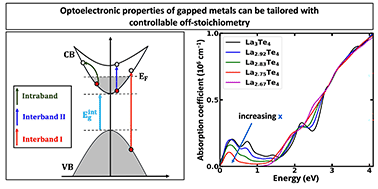Spontaneous off-stoichiometry as the knob to control the dielectric properties of gapped metals†
Abstract
Using first-principles calculations and La3Te4 as an example of an n-type gapped metal, we demonstrate that gapped metals can develop spontaneous defect formation resulting in off-stoichiometric compounds. Importantly, these compounds have different free carrier concentrations and can be realized by optimizing the synthesis conditions. The ability to tune the free carrier concentration allows the tailoring of the intraband and interband transitions, thus controlling the optoelectronic properties of materials in general. Specifically, by realizing different off-stoichiometric La3−xTe4 compounds, it is possible to reach specific crossings of the real part of the dielectric function with the zero line, reduce the plasma frequency contribution to the absorption spectra, or, more generally, induce metal-to-insulator transition. This is particularly important in the context of optoelectronic, plasmonic, and epsilon-near-zero materials, as it enables materials design with a target functionality. While this work is limited to the specific gapped metal, we demonstrate that the fundamental physics is transferable to other gapped metals and can be generally used to design a wide class of new optoelectronic/plasmonic materials.

- This article is part of the themed collection: 2023 PCCP HOT Articles


 Please wait while we load your content...
Please wait while we load your content...